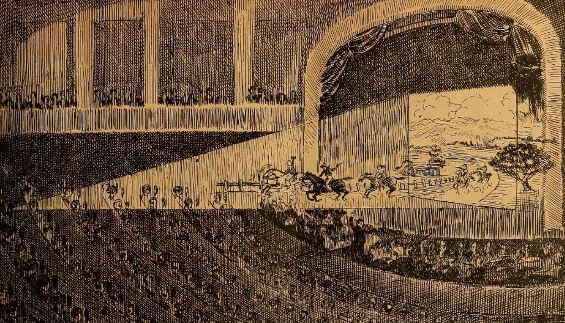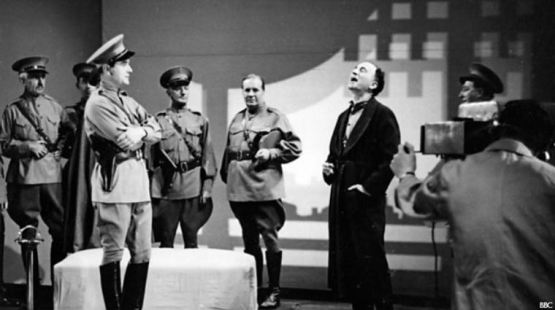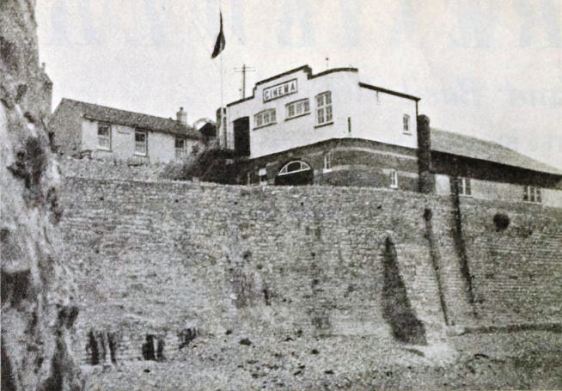Source: E.C. [Elsie Cohen]. ‘An Impression of “Intolerance” and its Creator’, Kinematograph and Lantern Weekly, 12 April 1917, p. 6
Text: AN IMPRESSION OF “INTOLERANCE” AND ITS CREATOR
Wonderful Premiere of the New D. W. Griffith Masterpiece at Old Drury
Historic Old Drury, whose very walls seem to breathe of past glories, of nights of triumph on the stage of other days, was, indeed, a fitting centre for the scene enacted on Saturday night. What better place could be found for the supreme triumph of the new art than that trod by the celebrities of a bygone generation; a link with the eventful past of the legitimate drama of Britain.
It was a night that will not easily be forgotten. The wonderful old house was once again the scene of a great triumph; the triumph of the new art that does not replace, but stands side by side with the old. Never, perhaps, with all its past glories have the rafters of Drury Lane Theatre re-echoed with the shouts and applause of the people as they did for David Wark Griffith’s inspired work, “Intolerance.” Spellbound, the vast audience sat for three hours, now swayed almost to tears by the power and pathos of the silent drama so vividly depicted, now thrilled by the vastness and magnitude and grandeur of the old Babylonian city and the old-time warfare, so unlike and yet so like that which is tearing the world’s heartstrings to-day. And through it all sat, imperturbable, the genius who had conceived this masterpiece, the man to whom the world of kinematography owes such a debt of gratitude. To attempt to give an impression of David Wark Griffith is difficult. That he is a genius one may say with certain knowledge; that he is one of the most charming, and if it may be said, most English Americans one has ever met, might also be added. My conversation with Mr. Griffith took place in a room at the Savoy Hotel overlooking old Father Thames, and the eye of the true artist wandered appreciatively towards the golden sunset, throwing shadows on the murky waters. Here, in the midst of the greatest city in the world was a scene of beauty appreciated to the full by a man highly sensitive to impression and environment.
“Your London is a wonderful city,” said Mr. Griffith, “just wonderful, and there are no fairer spots in all the world than around your country-side. What backgrounds for pictures, what atmosphere,” and then we went on to talk of other things, and all too soon the interesting interview came to a close.
And when I again heard the name Griffith, it was being shouted from thousands of throats at Old Drury on Saturday night. From stalls to topmost gallery it echoed and re-echoed, and in response there appeared on the time-honoured boards, the tall, aristocratic figure of the man of the moment. And as he had swayed the people by his consummate art, so he still swayed them by the power of his personality and the eloquence of his speech. David Wark Griffith is, indeed, a great man.
To give an impression of the film is almost as difficult a task as to give one of its creator. That it is colossal, thrilling, unique, stupendous, wonderful, might be said with truth, but it is something more than all the adjectives can convey. Dealing with love’s struggle throughout the ages against intolerance, it seek to teach a lesson, sometimes by the force of true drama, sometimes by gentle satire, but always by a human cord binding the threads that connect the ancient and modern. Human nature is the same to-day as yesterday, will be the same till the end of all time, and the depiction of humanity, or lack of it, in “Intolerance,” make it a picture not of the moment but one whose lesson can be taught until all things come to an end. It has a universal appeal by reason of the story it seeks to tell — ” Love’s struggle throughout the ages.”
As a spectacle it is safe to that it has never been surpassed, and probably not equalled. There are four separate stories, each interwoven into the other, and here some criticism has been levelled. It has been said that it lacks continuity of action, making the story difficult to follow. True, we go from a modern court room scene to ancient Babylon, the change only marked by the woman by the side of the cradle eternally rocking, but thus we get the parallel and the true, conception of intolerance; the criticism is only in a minor degree justified.
There is the modern story, showing how it is possible for men pretending philanthropy really to work injury and misery to their fellows; the story of Christ teaching the law of love and kind tolerance, and how he perished on the Cross of Calvary, treated with a reverence that should satisfy all, and the story of France of the middle ages, all produced with a splendour and magnificence that bear the distinctive touch of their producer.
The Babylonian scenes are probably the most grandiloquent and striking of this feast of magnificence. The attack the ancient walls and towers of Babylon, the masses of warriors, 67,000 men in one scene, are awe-inspiring, and the spectacular effects truly brilliant.
It is a vivid and kaleidoscopic panorama of artistry. There are visions of moving clouds with wonderful tinting than which we have never had anything more beautiful; Mae Marsh’s acting, too, will live long in the memory. As in that other Griffith masterpiece, “The Birth of a Nation,” she sounds the depths of human emotion, and gives us again of her wonderful art.
This is, perhaps, an inadequate description of “Intolerance.” It inevitably must be, for to convey a true impression would be impossible by the power of the written word.
Whether “Intolerance” will be a success in this country it is difficult to say. By its first reception one would say that it would. I, at any rate, thank Mr. Griffith for a very wonderful night, and hope the picture will meet with the which it deserves. I have seen “Intolerance” once; I hope to see it many more times.—E.C.
Comments: Elsie Cohen (1895-1972), a naturalised Briton of Polish-Jewish ancestry, was a film journalist, film publicist, studio manager and then cinema manager, famous for managing the Academy art house venue in London in the 1930s. At the time of this article she was working for British film trade paper the Kinematograph and Lantern Weekly and about to be promoted to associate editor. D.W. Griffith’s feature film Intolerance was released in 1916. It had its British premiere at Drury Lane theatre on 7 April 1917.





